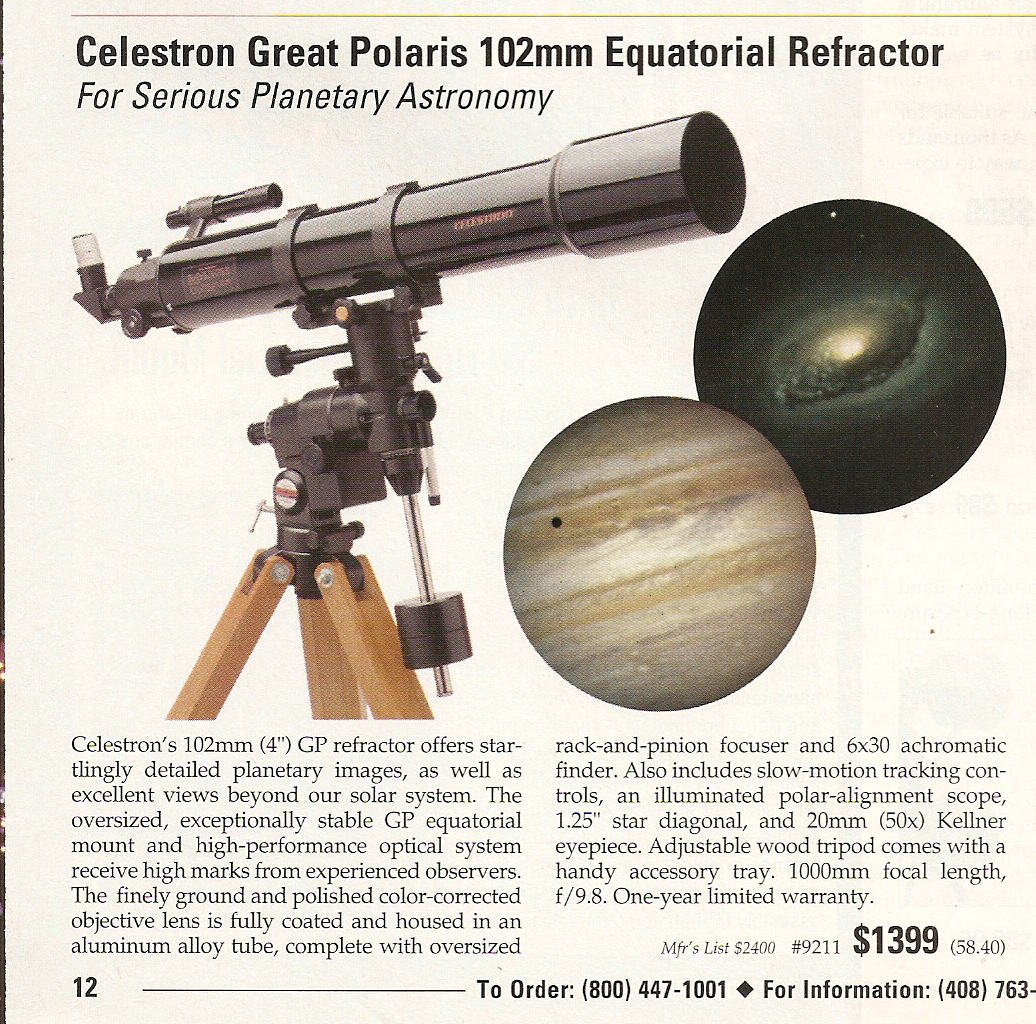
Updated 4/17/13, 5/9/13
1) Celestron C102 4" f/9.8 achromat (2013 version) 4/11/13, 5/9/13
2) Orion GoScope 80 mm Refractor 4/17/13
(4" f/9.8 achromatic refractor, various configurations and options, $150-$200 street for OTA, $499 for CG-4 mounted XLT version)
Are you as amazed as I am at how good cheap telescopes are these days? The parade of good, inexpensive stuff never seems to stop.
Celestron's C102 refractor has been in their lineup for a long time - 20 years at least. The original Vixen-made version from the 1990s was bundled with the old Super/Great Polaris mount for $1400, an unheard of price for a 4" achromat at the time. Yet, owners looking for that clear, sharp refractor experience ponied up the dollars and never looked back. Around the year 2000, Celestron moved the production overseas, and the Chinese-made C102HD was born. I remember browsing through the Celestron catalog with my friends at the time, and all of us thought the price was a misprint - $650 for essentially the same scope as the old Vixen. Many of us ran down to our local telescope shops (remember those?!) to buy one, and I spent many happy nights looking through mine.

Celestron's original Vixen-made GPC-102 refractor. From the Fall 1997
Orion catalog. Check out the price!
The basic optical tube has gone through many iterations through the years, and is still in the Celestron catalog as of this writing. The current version is the XLT, which has the same optics as the tube shown below, wrapped in different cosmetics, and mounted on a CG-4. And my, how the price has gone down! Prices for the optical tube have fallen to the $200 level, and I've even seen discounts far below that level from time to time. A recent sale from OPT caught my interest, and as it's been a decade or so since I last saw one of these, I bought one. (Note: 5/9/13. Readers remind me that the XLT version adds a metal lens cell that allows for collimation of the lens.)
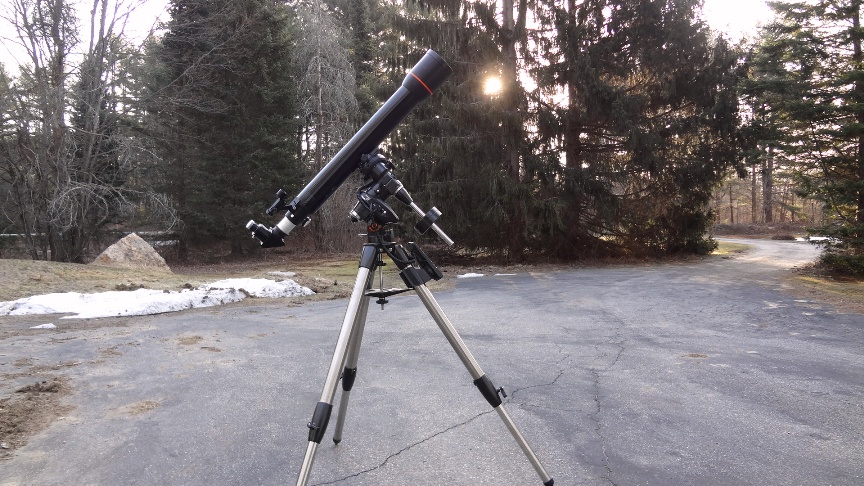
C102, 2013 version, on a CG-5 mount, the morning after a long observing session.
If you wind up with one of these NexStar versions, there are a few quirks. First of all, the dovetail plate is short, and mounted too far forward (a concession to the NexStar mount.) It's also mounted 90 degrees away from the usual position, so your focuser will be turned at a strange angle. If you get one, I'd highly recommend getting a set of 4" rings from Orion (#7371) or Scopestuff (#CR40) and a longer plate. Putting a 2" diagonal into the focuser exacerbates the problem; the entire optical tube keeps wanting to fall backwards. Also, the red dot finder on mine has a stop built into the base that prevents you from angling the finder forward. As a result, the back of the finder is too close to your eyes. I'm going to shave off the stop and mount it the correct way. Finally, the dew shield is incredibly short - the shield only extends 3" beyond the lens. It's so short that I thought for sure the thing would extend, but it doesn't. You can either buy a commercial dew shield, or make one yourself out of craft foam. Note that if you buy the current XLT version of the C102, you won't have any of these problems.
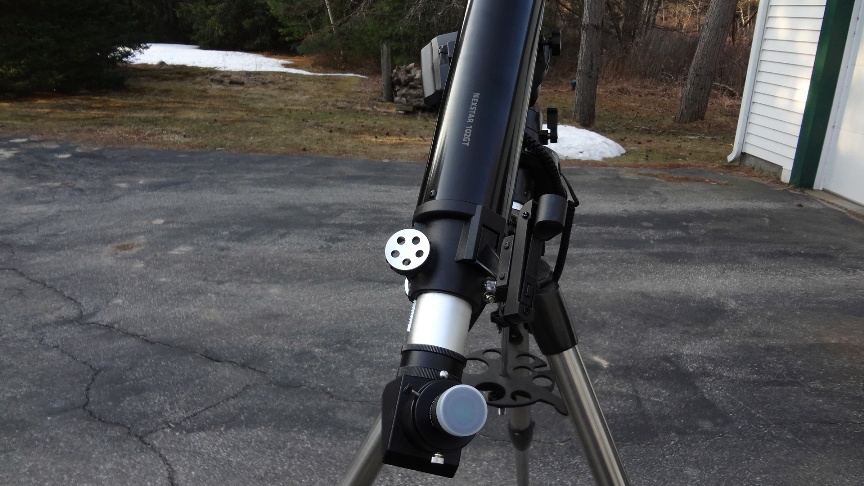
If you get the NexStar version, the tube and focuser will be rotated 90 degrees.
So how does it perform? Like all versions of the C102, very well. The star test revealed only minor undercorrection. There was a slight yellowing of white stars, which is typical of achromats. The longish f/9.8 focal ratio keeps false color to a minimum, but die-hard apochromat fans will immediately notice the blue halos around bright stars, Jupiter, and the limb of the moon. Pump the power up on Saturn and you'll see a faint blue halo around the yellow planet as well.
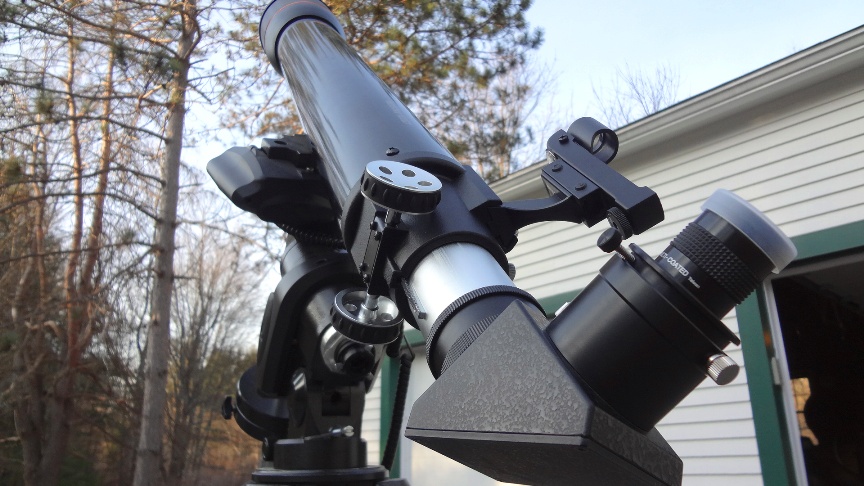
With a 2" diagonal, the tube becomes back heavy. Recommendation - get a pair of rings.
On a stretch of calm, clear nights in March and April of 2013, I spent several nights with the OTA. I caught a nice Ganymede shadow transit, right next to the GRS on Jupiter. I watched for several hours as Jupiter rotated and the shadow slowly marched across the white planet. Castor was easily split at 76X. My scope came with "OPT" branded 25 mm and 10 mm eyepieces. They appear to be the same as the old Celestron E-Lux models. I stayed with the stock eyepieces for a while before switching to a 2" Orion diagonal and premium eyepieces. With 19 mm and 35 mm Panoptics, I did a late tour of the winter objects before they sank into the western horizon for the season. I had pleasant views of M42, M35/NGC2138, M37, M36, and M38/NGC1907. The smaller companion clusters around M35 and M38 showed as dim smudges with the 35 mm Panoptic, and started to show some shape with the 19 mm Panoptic.
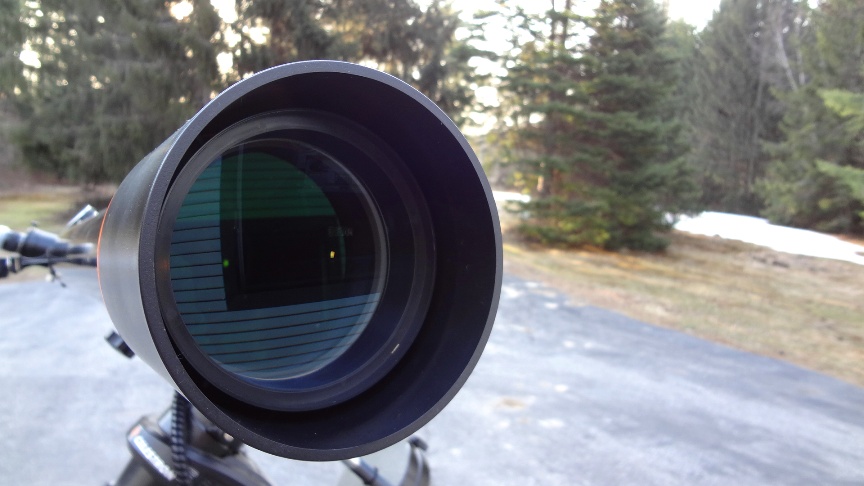
Looking Down the OTA. The lens has deep dark green coatings - a good sign.
But the dew shield is way too short.
On another night, I set the scope outside for one last test. The 12.5" Obsession sat nearby; my intention was to use the C102 for a while, take some notes, and then switch to the Big Guy for some serious deep sky work. As it turned out, I was having so much fun with the C102, I never wound up using the Obsession. While the larger scope would certainly have shown me more, I found on that night it was more interesting to see how far I could push a 4" refractor. I started with M81 and M82 - no problem there. M101 and M97/M108 were a little dimmer, but were still within the grasp of the C102. With Leo rising in the east, I thought I'd try for a bigger challenge. By the end of the evening, I had bagged all of the Messier galaxies in the Virgo Cluster, as well as some of the brighter NGC members of Markarian's Chain. Granted, this was an exceptional night for New Hampshire - the dew point was 11 degrees - but it shows how much work you can accomplish with a mere 4" telescope.
Like all versions of Celestron's C102, this one is highly recommended. I hope it stays in their lineup for another 20 years.
Celestron C102 Hots:
Very good optics
Offers a taste of high end refractor sweetness
Low cost
Celestron C102 Nots:
False color on bright objects
Mechanical quirks on my NexStar version
Hard to keep up with the changing versions of the same basic OTA
Verdict:
Like the venerable 6" reflector, owning a C102 is a rite of passage for many amateur astronomers. Highly recommended.
2) Orion GoScope 80 mm Refractor 4/17/13
(80 mm f/4.3 achromat, table top Alt-Az mount, EZ Finder II red dot finder, dovetail plate, 1.25" thread on diagonal, 20 mm, 10 mm eyepieces, $129 list)
While you weren't looking, cheap scopes have been getting better lately. While none of the sub $200 scopes are ideal, they are a far cry from the useless department store telescopes that have traditionally plagued our hobby. Shoppers on a budget now have real choices. I still recommend the 4.5" Starblast (both the $199 Dob or the $229 equatorial version) or the $249 Orion Skyquest XT 4.5 for cash-strapped observers. But there's a recent crop of super-budget scopes on the market. Not long ago I reviewed the $59 Celestron #21024 3" f/4 Dob. My conclusions were mixed, as they will be here with this GoScope.
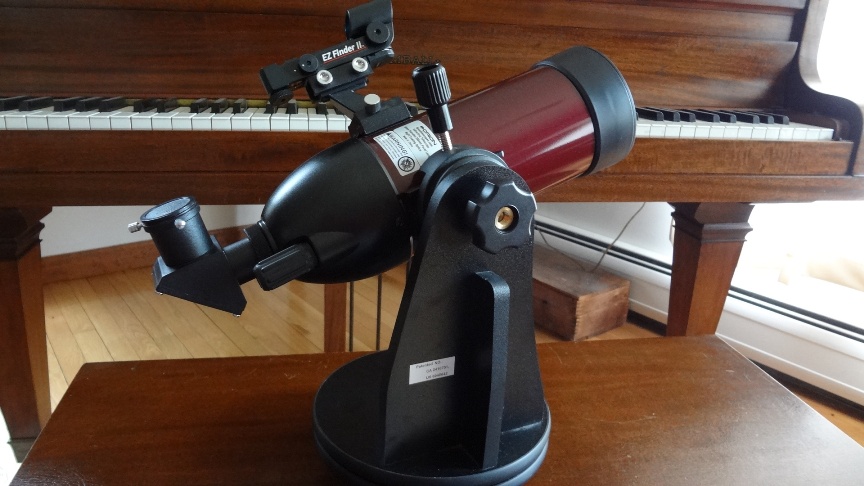
Orion's 80 mm GoScope refractor
The 80 mm GoScope is part of a trio of table top telescopes from Orion. The other two are a 4" f/4 reflector for $119, and a version of their Apex 90 mm Maksutov on an Alt-Az mount for $199. I have reservations about all three. The Newtonian has issues with optical quality (it's essentially a larger version of the Celestron #21024/Orion FunScope.) The Mak, while it has good optics, operates at too high a power, and at too narrow a field of view for the mount, and I can picture beginners getting frustrated with it. It also costs substantially more than the reflector or the refractor.
The 80 mm GoScope has a super-fast f/4.3 doublet achromat. The focuser moves the primary lens back and forth within the tube using a Schmidt-Cassegrain-like knob on the back of the scope. With any moving-primary system, image shift is a concern, but I didn't see any issues here. Also, unusually, the diagonal threads on. You need to be careful with it - it's made of plastic, and replacement 1.25" thread-on diagonals are not exactly common. On top, there's Orion's own EZ Finder II - this part alone sells for $49 in the Orion catalog. The mount's Alt-Az motions are decent and should be more than adequate for the low power wide field viewing that you'll do with the scope. However, the scope will not point at the zenith, even with the dovetail plate clamped fully forward. So mechanically, the scope is sound, if a little unusual, and if you add up the cost of the finder, the two eyepieces, and the dovetail plate, you could easily spend around $100. If the scope threw up any images at all, you'd think the scope would be self-recommending.
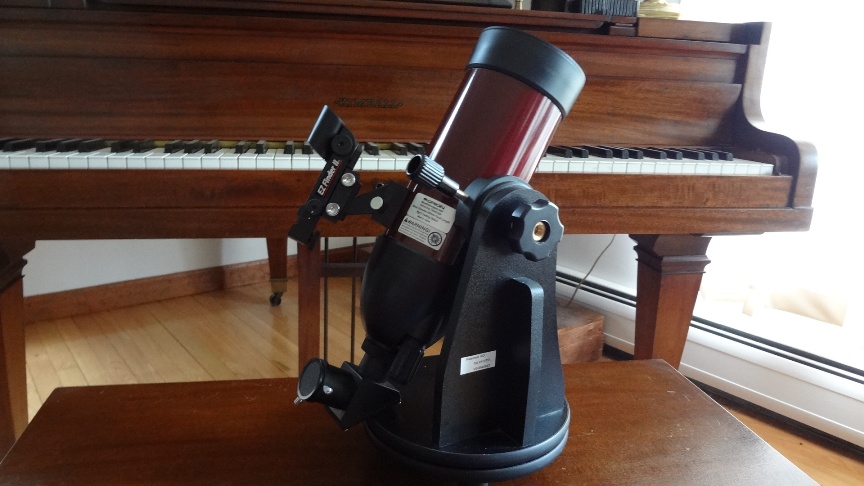
The scope will not point at the zenith. This is as high as it will go.
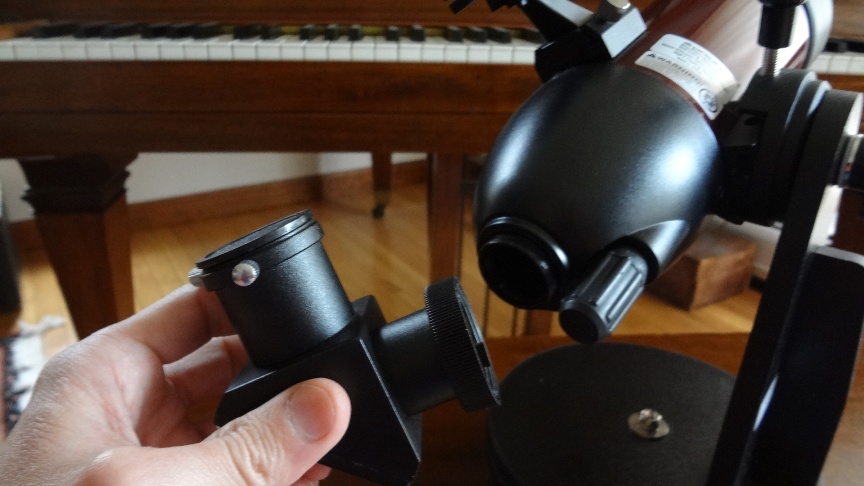
The diagonal is a thread-on plastic piece. Note focus knob, right.
Your first challenge is going to be figuring out what to set the scope on. I settled on my tried and true solution for table top scopes these days - I have a set of plastic tubs that I got from Wal-Mart. The tubs double as storage for the scopes when I'm not using them. With very short scopes like this one, I sometimes wind up using more than one tub. If you have a decent tripod, there's a threaded hole at the bottom of the mount. Be sure that your tripod can handle the 5.7 lb weight of the scope. If not, your rig will be top heavy and you'll have a disaster waiting to happen. The scope also spent time aboard my NexStar mount, which helped immensely. Note that if you do this yourself, the NexStar will place the finder at an inconvenient angle.
So, how does the scope perform, optically? Well...
You'd expect an f/4.3 achromat would throw up a lot of false color, and you'd be right. Purple halos surround any bright object; even beginners had no trouble seeing it. If you think your Orion Short Tube 80 has a lot of false color, wait'll you see this one. The star test was a bit of a mess as well. Inside of focus, the diffraction rings looked reasonable, but outside of focus, the pattern was an ill-defined roundish mush. Now, bad star tests don't always translate into poor views. But in this case, the views of Jupiter began to break down at 35X using the 10 mm eyepiece. Yes, 35X. The view sharpened up at 17X with the 20 mm eyepiece, but Jupiter is so small at 17X it's hard to see anything. The first quarter moon did look decent, however. The first time I saw the scope, it was mid-winter, and I had some fun panning around to the big showpiece objects like M42 (the Orion Nebula), M31 (the Andromeda Galaxy), and M45 (the Pleaides.) But the next time I had the scope it was mid April, and there weren't many bright deep sky objects to see. I did manage to catch M35, M37, M36, and M38, but they were dim. The GoScope is aimed at beginners. Would they know how to find these star clusters, and would they have the acuity to resolve these tiny smudges of light? The scope will split Mizar/Alcor. I also saw M81 and M82, but without my guidance, a beginner nearby would never have noticed them in the eyepiece. I also noticed that the field is not flat. Stars near the edges were curved. My Naglers and Panoptics helped this problem, but how many beginners are going to put a $300 eyepiece into a $129 scope? Forget that, how many beginners are even aware that there are such things as $300 eyepieces?
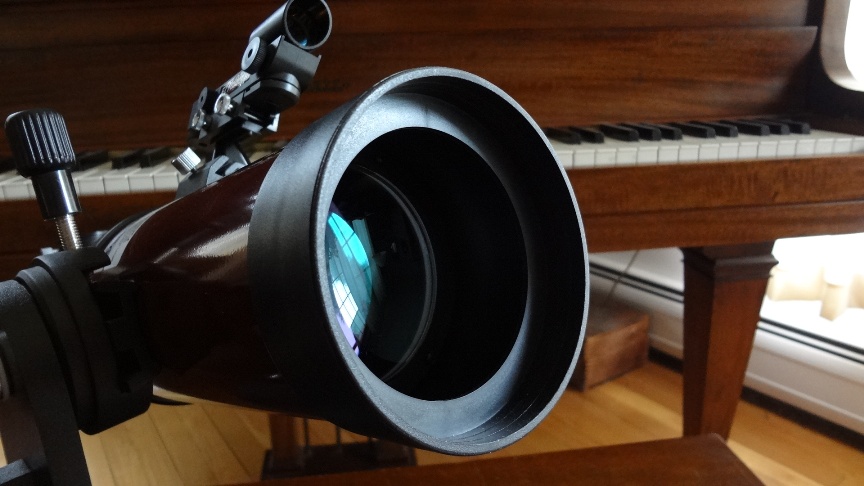
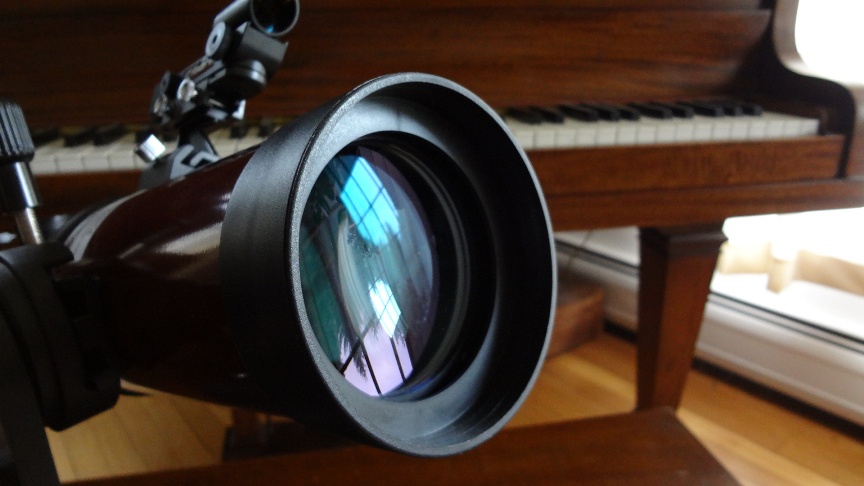
Rack in, Rack out, Mr. Miyagi!!
The problem isn't the aperture. 80 mm is plenty. On the December night, a local club member had one of the new Vixen 80 mm EDsf refractors and it was performing superbly. I had my 70 mm TeleVue Ranger out and it was catching all kinds of objects. Train the 80 mm GoScope on these same objects and it's just in a different league. Unlike the better scopes, pushing the power almost always degraded the images, sometimes severely. We discovered another issue with the scope - it will not come to focus with the Orion Shorty barlow in it. There isn't enough travel in the focusing mechanism to accommodate the barlow. It's just as well, since the scope's optics probably wouldn't have handled the magnification well.
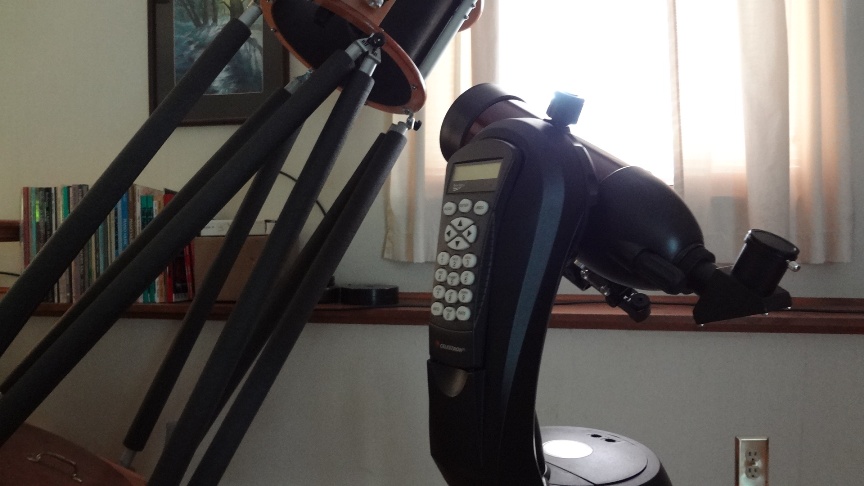
The GoScope worked well on the NexStar mount. Pay no attention to the Obsession in the background...
So while it's certainly a good bargain, buyers need to be aware that the GoScope is extremely limited. It will show you the moon and perhaps some larger/brighter deep sky objects, but if neither are around, you're going to run out of things to look at pretty fast. Am I complaining too much given the price point? Maybe. After all, we're deep in department store territory here, and you could do much, much worse for your $129. The GoScope succeeds where department store telescopes do not - namely, by what it doesn't do. No "575X" magnification claims. No useless cheap Goto electronics. No flimsy tripod masquerading as a serious mount. No, the GoScope gives you adequate optics, a decent table top mount, and good accessories, and that's it. It doesn't pretend to be something it's not. On the other hand, "you could do worse" is hardly a ringing endorsement, and if you could find a way to spend just a little more -$199 say- you could equip yourself with a 4.5" Starblast, which is a bona-fide, serious telescope. Should you get one? In terms of the amount of physical product you're buying, I would say yes, you are getting your money's worth. Ultimately, you will have to decide whether or not you are going to get $129 worth of performance out of the optics, and that's a dicier proposition. If you get one, keep it at low power, and have a knowledgeable companion handy.
As for me? I'm on the fence. Your move.